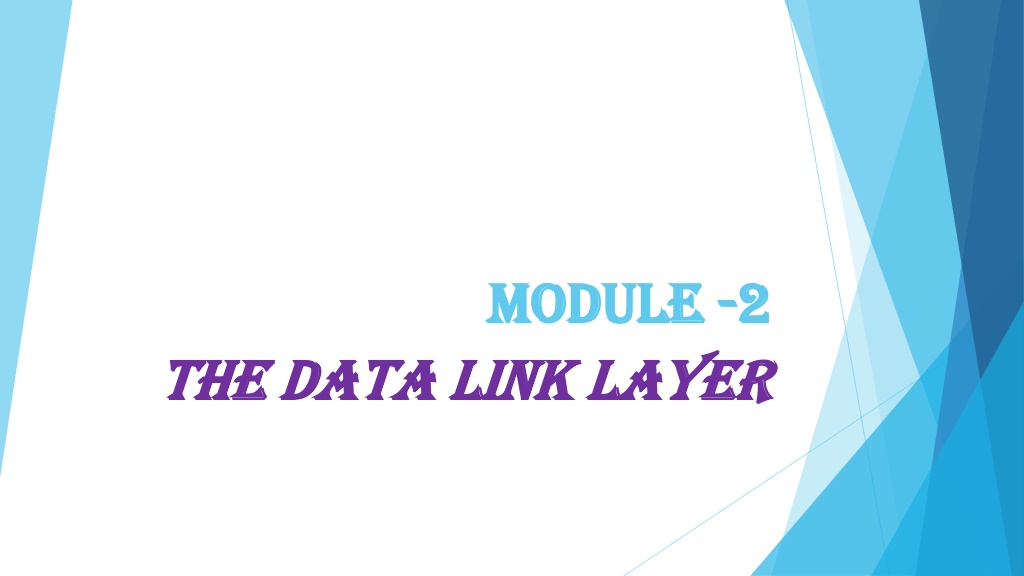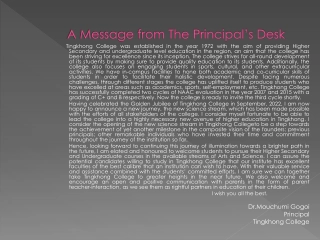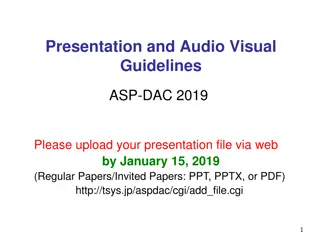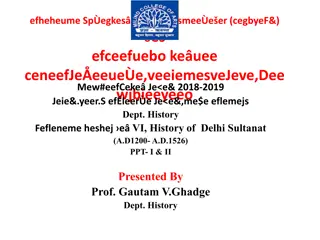
Understanding Data Link Layer Functions and Design Issues
Explore the functions of the data link layer, such as providing a service interface to the network layer, dealing with transmission errors, and regulating data flow. Learn about framing, services to the network layer, and framing methods.
Download Presentation

Please find below an Image/Link to download the presentation.
The content on the website is provided AS IS for your information and personal use only. It may not be sold, licensed, or shared on other websites without obtaining consent from the author. Download presentation by click this link. If you encounter any issues during the download, it is possible that the publisher has removed the file from their server.
E N D
Presentation Transcript
Module Module - -2 2 THE DATA LINK LAYER THE DATA LINK LAYER
Data link layer design issues The data link layer uses the services of the physical layer to send and receive bits over communication channels. It has a number of functions, including: 1. Providing a well-defined service interface to the network layer. 2. Dealing with transmission errors. 3. Regulating the flow of data so that slow receivers are not swamped by fast senders.
Services provided to network layer The function of the data link layer is to provide services to the network layer. The principal service is transferring data from the network layer on the source machine to the network layer on the destination machine.
The actual services that are offered vary from protocol to protocol. 1. Unacknowledged connectionless service. 2. Acknowledged connectionless service. 3. Acknowledged connection-oriented service.
Framing To provide service to the network layer, the data link layer must use the service provided to it by the physical layer. The usual approach is for the data link layer to break up the bit stream into discrete frames. compute a short token called a checksum for each frame, and include the checksum in the frame when it is transmitted.
Alternate methods for framing 1. Byte count. 2. Flag bytes with byte stuffing. 3. Flag bits with bit stuffing. 4. Physical layer coding violations.
flag byte byte stuffing the next question is: what happens if an escape byte occurs in the middle of the data?
HDLC (High- level Data Link Control) protocol. Each frame begins and ends with a special bit pattern, 01111110 or 0x7E in hexadecimal. This pattern is a flag byte.
A common pattern used for Ethernet and 802.11 is to have a frame begin with a well-defined pattern called a preamble.
Error control Uses the techniques of error control simply to ensure and confirm that all the data frames or packets. Introducing timers into the data link layer. When the sender transmits a frame, it generally also starts a timer.
Flow control It is a technique that generally observes the proper flow of data from sender to receiver. It is possible for sender to transmit data or information at very fast rate and hence receiver can receive this information and process it. Two approaches are commonly used: In the first one, feedback-based flow control , the receiver sends back information to the sender giving it permission to send more data. In the second one, rate-based flow control , the protocol has a built-in mechanism that limits the rate at which senders may transmit data, without using feedback from the receiver
Error Detection and Correction Two basic strategies for dealing with errors. One strategy is to include enough redundant information to enable the receiver to deduce what the transmitted data must have been. The other is to include only enough redundancy to allow the receiver to deduce that an error has occurred and have it request a retransmission. The use of error-correcting codes is often referred to as FEC (Forward Error Correction).
FEC is used on noisy channels because retransmissions are just as likely to be in error as the first transmission. Sometimes, the location of an error will be known, perhaps because the physical layer received an analog signal that was far from the expected value for a 0 or 1 and declared the bit to be lost. This situation is called an erasure channel .
Error correcting codes Four different error-correcting codes: 1. Hamming codes. 2. Binary convolutional codes. 3. Reed-Solomon codes. 4. Low-Density Parity Check codes.
In a block code, the r check bits are computed solely as a function of the m data bits with which they are associated, as though the m bits were looked up in a large table to find their corresponding r check bits. In a systematic code, the m data bits are sent directly, along with the check bits, rather than being encoded themselves before they are sent. In a linear code , the r check bits are computed as a linear function of the m data bits.
(n = m + r ) (m/n) Hamming distance.
The error-detecting and error-correcting properties of a block code depend on its Hamming distance. To reliably detect d errors, you need a distance d + 1 code. to correct d errors, you need a distance 2d + 1 code In Hamming codes the bits of the codeword are numbered consecutively, starting with bit 1 at the left end, bit 2 to its immediate right, and so on.
This approach of working with the uncertainty of a bit is called soft-decision decoding . Conversely, deciding whether each bit is a 0 or a 1 before subsequent error correction is called hard-decision decoding . The third kind of error-correcting code we will describe is the Reed-Solomon code. Reed-Solomon codes are actually defined as polynomials that operate over finite fields, but they work in a similar manner. For m bit symbols, the codewords are 2 m 1 symbols long. A popular choice is to make m = 8 so that symbols are bytes. A codeword is then 255 bytes long. The (255, 233) code is widely used; it adds 32 redundant symbols to 233 data symbols. Decoding with error correction. The final error-correcting code we will cover is the LDPC (Low-Density Parity Check ) code.
Error detecting codes Error-correcting codes are widely used on wireless links, which are notoriously noisy and error prone when compared to optical fibers. Three different error-detecting codes: 1. Parity. 2. Checksums. Cyclic Redundancy Checks (CRCs). 3.
there is something else we can do that provides better protection against burst errors: we can compute the parity bits over the data in a different order than the order in which the data bits are transmitted. Doing so is called interleaving .
The second kind of error-detecting code, the checksum , is closely related to groups of parity bits. The word checksum is often used to mean a group of check bits associated with a message, regardless of how are calculated. The Internet checksum in particular is efficient and simple but provides weak protection in some cases precisely because it is a simple sum. It does not detect the deletion or addition of zero data, nor swapping parts of the message, and it provides weak protection against message splices in which parts of two packets are put together.
A better choice is Fletchers checksum. a third and stronger kind of error-detecting code is in wide spread use at the link layer: the CRC (Cyclic Redundancy Check ), also known as a polynomial code. The algorithm for computing the CRC is as follows: 1. Let r be the degree of G (x ). Append r zero bits to the low-order end of the frame so it now contains m + r bits and corresponds to the polynomial x r M (x ). 2. Divide the bit string corresponding to G (x ) into the bit string corresponding to x r M (x ), using modulo 2 division. 3. Subtract the remainder (which is always r or fewer bits) from the bit string corresponding to x r M (x ) using modulo 2 subtraction. The result is the checksummed frame to be transmitted. Call its polynomial T (x ).
Polynomial codes are based upon treating bit strings as representations of polynomials with coefficients of 0 and 1 only. A k-bit frame is regarded as the coefficient list for a polynomial with k terms, ranging from x k -1to x 0. For example, 110001 has 6 bits and thus represents a six-term polynomial with coefficients 1, 1, 0, 0, 0, and 1: 1x 5 + 1x 4 + 0x 3 + 0x 2 + 0x 1 + 1x 0
A Utopian Simples Protocol
Useful links: http://www.digimat.in/nptel/courses/video/106105183/L49.html https://www.simplilearn.com/pgp-cyber...


















